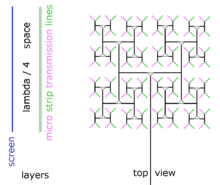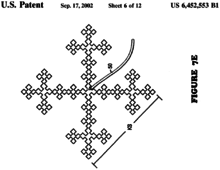Fractal antenna
A fractal antenna is an antenna that uses a fractal, self-similar design to maximize the effective length, or increase the perimeter (on inside sections or the outer structure), of material that can receive or transmit electromagnetic radiation within a given total surface area or volume.
| Part of a series on |
| Antennas |
|---|
 |
|
Common types |
|
Safety and regulation
|
|
Radiation sources / regions
|
Such fractal antennas are also referred to as multilevel and space filling curves, but the key aspect lies in their repetition of a motif over two or more scale sizes,[1] or "iterations". For this reason, fractal antennas are very compact, multiband or wideband, and have useful applications in cellular telephone and microwave communications. A fractal antenna's response differs markedly from traditional antenna designs, in that it is capable of operating with good-to-excellent performance at many different frequencies simultaneously. Normally standard antennas have to be "cut" for the frequency for which they are to be used—and thus the standard antennas only work well at that frequency.
In addition the fractal nature of the antenna shrinks its size, without the use of any components, such as inductors or capacitors.
Log periodic antennas and fractals
The first fractal "antennas" were, in fact, fractal "arrays", with fractal arrangements of antenna elements, and not recognized initially as having self-similarity as their attribute. Log-periodic antennas are arrays, around since the 1950s (invented by Isbell and DuHamel), that are such fractal arrays. They are a common form used in TV antennas, and are arrow-head in shape.
Fractal element antennas and performance

Antenna elements (as opposed to antenna arrays, which are usually not included as fractal antennas) made from self-similar shapes were first created by Nathan Cohen[4] then a professor at Boston University, starting in 1988. Cohen's efforts with a variety of fractal antenna designs were first published in 1995.[2] Cohen's publication marked the inaugural scientific publication on fractal antennas.
Many fractal element antennas use the fractal structure as a virtual combination of capacitors and inductors. This makes the antenna so that it has many different resonances which can be chosen and adjusted by choosing the proper fractal design. This complexity arises because the current on the structure has a complex arrangement caused by the inductance and self capacitance. In general, although their effective electrical length is longer, the fractal element antennas are themselves physically smaller, again due to this reactive loading.
Thus fractal element antennas are shrunken compared to conventional designs, and do not need additional components, assuming the structure happens to have the desired resonant input impedance. In general the fractal dimension of a fractal antenna is a poor predictor of its performance and application. Not all fractal antennas work well for a given application or set of applications. Computer search methods and antenna simulations are commonly used to identify which fractal antenna designs best meet the need of the application.
Studies during the 2000s showed advantages of the fractal element technology in real-life applications, such as RFID[5] and cell phones.[6] Fractals have been used in antennas since 1988[7] and their advantages[8] are good multiband performance, wide bandwidth, and small area[9] and that reference showed that the gain with small size results from constructive interference with multiple current maxima, afforded by the electrically long structure in a small area.
Some researchers have disputed that fractal antennas have superior performance. Steven R. Best in 2003 observed "that antenna geometry alone, fractal or otherwise, does not uniquely determine the electromagnetic properties of the small antenna".[10] In 2011, Robert C. Hansen and Robert E. Collin reviewed many papers on fractal antennas and concluded that they offer no advantage over fat dipoles, loaded dipoles, or simple loops, and that nonfractals are always better.[11] Balanis reported on several fractal antennas and found them equivalent in performance to the electrically small antennas they were compared to.[12] Log periodics, a form of fractal antenna, have their electromagnetic characteristics uniquely determined by geometry, via an opening angle.[13][14]
Fractal antennas, frequency invariance, and Maxwell's equations
A different and also useful attribute of some fractal element antennas is their self-scaling aspect. In 1957, V.H. Rumsey[14] presented results that angle-defined scaling was one of the underlying requirements to make antennas "invariant" (have same radiation properties) at a number, or range of, frequencies. Work by Y. Mushiake in Japan starting in 1948[15] demonstrated similar results of frequency independent antennas having self-complementarity.
It was believed that antennas had to be defined by angles for this to be true, but in 1999 it was discovered[16] that self-similarity was one of the underlying requirements to make antennas frequency and bandwidth invariant. In other words, the self-similar aspect was the underlying requirement, along with origin symmetry, for frequency 'independence'. Angle-defined antennas are self-similar, but other self-similar antennas are frequency independent although not angle-defined.
This analysis, based on Maxwell's equations, showed fractal antennas offer a closed-form and unique insight into a key aspect of electromagnetic phenomena. To wit: the invariance property of Maxwell's equations. This is now known as the HCR Principle. Mushiake's earlier work on self complementarity was shown to be limited to impedance smoothness, as expected from Babinet's Principle, but not frequency invariance.
Other uses
In addition to their use as antennas, fractals have also found application in other antenna system components including loads, counterpoises, and ground planes.
Fractal inductors and fractal tuned circuits (fractal resonators) were also discovered and invented simultaneously with fractal element antennas.[1][17] An emerging example of such is in metamaterials. A recent invention demonstrates using close-packed fractal resonators to make the first wideband metamaterial invisibility cloak at microwave frequencies.[18][19]
Fractal filters (a type of tuned circuit) are another example where the superiority of the fractal approach for smaller size and better rejection has been proven.[20][21][22]
As fractals can be used as counterpoises, loads, ground planes, and filters, all parts that can be integrated with antennas, they are considered parts of some antenna systems and thus are discussed in the context of fractal antennas.
See also
- Waveguide (electromagnetism)
References
- Nathan Cohen (2002) "Fractal antennas and fractal resonators" U.S. Patent 6,452,553
- Cohen, Nathan (Summer 1995). "Fractal antennas Part 1". Communications Quarterly. 5: 7–22. ISSN 1053-9433.
- Ghosh, Basudeb; Sinha, Sachendra N.; and Kartikeyan, M. V. (2014). Fractal Apertures in Waveguides, Conducting Screens and Cavities: Analysis and Design, p.88. Volume 187 of Springer Series in Optical Sciences. ISBN 9783319065359.
- "Fractal Antenna Systems, Inc". www.fractenna.com. Retrieved 22 April 2018.
- Ukkonen L, Sydanheimo L, Kivikoski M (26–28 March 2007). "Read Range Performance Comparison of Compact Reader Antennas for a Handheld UHF RFID Reader". IEEE International Conference on RFID, 2007. pp. 63–70. doi:10.1109/RFID.2007.346151. ISBN 978-1-4244-1013-2. Lay summary.
- N. A. Saidatul; A. A. H. Azremi; R. B. Ahmad; P. J. Soh; F. Malek (2009). "Multiband Fractal Planar Inverted F Antenna (F-Pifa) for Mobile Phone Application". Progress in Electromagnetics Research B. 14: 127–148. doi:10.2528/pierb09030802. Archived from the original on 19 July 2010.
- Cohen, N. (Summer 1995). "Fractal Antennas Part 1". Communications Quarterly: 12 sidebar, 'The First Fractal Antenna'. ISSN 1053-9433.
- John Volakis, Ch-Chi Chen, and Kyohei Fujimoto," Small Antennas", ch. 3.2.5, McGraw Hill, 2010 ISBN 9780071625531
- Michael Frame, and Nathan Cohen, "Benoit Mandelbrot: A Life in Many Dimensions", ch 8: "Fractal Antenna and Fractal Resonator Primer", ch 8.4, World Scientific Press, 2015 ISBN 9789814366069
- Best, S.R. (2003). "A Comparison of the Resonant Properties of Small Space-Filling Fractal Antennas". IEEE Antennas and Wireless Propagation Letters. 2 (1): 197–200. Bibcode:2003IAWPL...2..197B. doi:10.1109/1-awp.2003.819680.
- Robert C. Hansen, Robert E. Collin, Small Antenna Handbook, ch. 5.13, John Wiley & Sons, 2011 ISBN 1118106857
- Constantine A. Balanis, "Modern Antenna Handbook", ch. 10.9, John Wiley & Sons, 2011 ISBN 978-1-118-20975-2
- Alois Krischke, "Rothammel's Antenna Book", 27.5, DARC Verlag, 2019 ISBN 9783000624278
- Rumsey, V.H. "Frequency Independent Antennas", IRE International Convention Record, Vol. 5, Part 1, pp.114-118, 1957
- Mushiake, Y. (March 1949). "Origination of self-complementary structure and discovery of its constant-impedance property". The Journal of the Institute of Electrical Engineers of Japan (in Japanese). 69 (3): 88.
- Hohlfeld R, Cohen N (1999). "Self-similarity and the geometric requirements for frequency independence in Antennae". Fractals. 7 (1): 79–84. doi:10.1142/S0218348X99000098.
- US 7,256,751, Cohen, Nathan, "Fractal antennas and fractal resonators"
- U.S. Patent 8,253,639
- Cohen, N. (2012). "Body sized wide-band high fidelity invisibility cloak". Fractals. 20 (3n04): 227–232. Bibcode:2012Fract..20..227C. doi:10.1142/s0218348x1250020x.
- Lancaster, M.; Hong, Jia-Sheng (2001). Microstrip Filters for RF/Microwave Applications. New York: Wiley. pp. 410–411. ISBN 978-0-471-38877-7.
- Pourahmadazar, J.; Ghobadi, C.; Nourinia, J.; Shirzad, H. (2010). "Mutiband ring fractal monopole antennas for mobile devices". IEEE Antennas and Wireless Propagation Letters. 9: 863–866. Bibcode:2010IAWPL...9..863P. doi:10.1109/LAWP.2010.2071372.
- Pourahmadazar, J.; Ghobadi, C.; Nourinia, J. (2011). "Novel modified pythagorean tree fractal monopole antennas for UWB applications". IEEE Antennas and Wireless Propagation Letters. 10: 484–487. Bibcode:2011IAWPL..10..484P. doi:10.1109/LAWP.2011.2154354.
